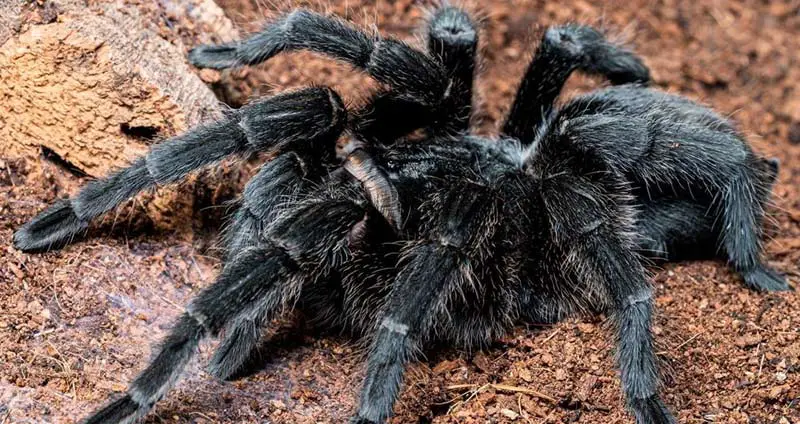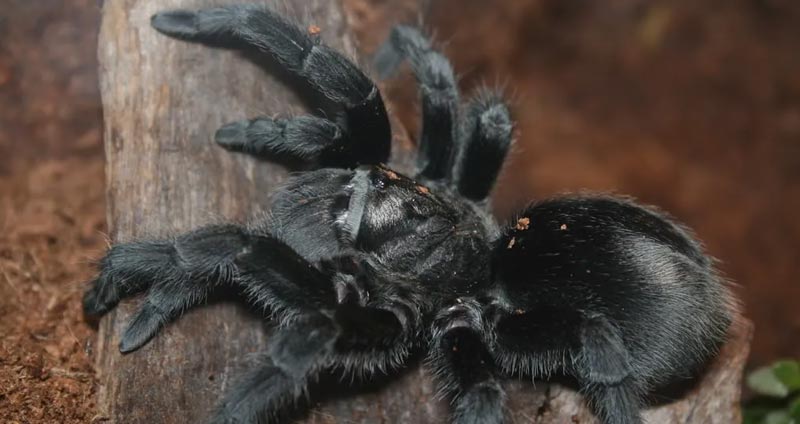With hundreds of types of tarantulas in existence today, there’s bound to be some that stick out from the rest in terms of appearance and personality.
This tarantula, Grammostola pulchra, stands out in both of those categories! It’s a very unique tarantula with a beautiful appearance and agreeable personality.
This care sheet will tell you everything that you need to know about caring for and appreciating Grammostola pulchra, otherwise known as the Brazilian Black Tarantula.
Table of Contents
Grammostola pulchra Care Sheet
Common Name
|
Brazilian Black |
Species Type |
New world terrestrial |
Habitat |
Found in a relatively humid and warm area of Brazil, spending most of its time burrowed into the dirt. |
Growth Rate |
Slow growth rate. This tarantula’s stages of life seem to be stretched out, and they reach full legspan at a very slow rate. |
Adult Size |
Females reach a legspan of between 7″ and 8″, with males measuring slightly smaller. |
Lifespan |
Females can live up to 30 years, while males can live up to 8 years. |
Enclosure |
The enclosure should have plenty of floor space with several inches of substrate to allow for burrowing. Inside the enclosure should be a hide, a water bowl, and some fake plants as accessories. |
Temp/Humidity |
75°F to 80°F with about 55% to 65% humidity. |
Diet |
Ravenous, aggressive eater. Will readily attack any prey that’s placed in its enclosure. Half a dozen adult crickets per week is generally a healthy amount. |
Temperament |
A surprisingly docile species. Very slow-moving and doesn’t become defensive or aggressive easily. Can kick hairs when threatened, though. |
Experience Level |
Beginner – An easy to care for tarantula species that has a very agreeable temperament. |
Average Cost |
Slings ~ $80 – $100, Males ~ $150 – $200, Females ~ $200+ |
Grammostola pulchra Appearance
As its nickname suggests, the Grammostola pulchra possesses a jet-black coat all along its abdomen, arms, and legs — even as a tiny sling!
The sleek design of this tarantula makes it highly sought out by most collectors and enthusiasts.
Light tends to bounce off of its hairs, giving the illusion of white hairs mixed into its darker coat. After a fresh molt, you will notice that the coat of your G. pultra will be an alluring dark black, which sparks intrigue in a lot of collectors of this fascinating creature.
Add this to 6 to 8 inches of potential growth—including leg span as an adult—and you have quite the stunning tarantula!
These tarantulas have a very slow growth rate compared to other species, but if you are properly feeding and heating the tarantula, then you may see accelerated results in growth and development.
It is also worth noting that these tarantulas are highly valued because of their long lifespan: males tend to live up to 8 years, and females can live up to several decades!
No matter what sex your Brazilian Black Tarantula is, if you acquire one at a young age, you will have one that will last for years to come!

Grammostola pulchra Temperament
As a line of defense against threats, most new world spiders use their urticating hairs as a defense mechanism by flicking these barbed hairs at predators to cause severe irritation.
Grammostola pulchra, in line with most other new world tarantulas, is more likely to flee than fight when it feels threatened — even though it has this effective defense tactic in its arsenal!
Because of this, it’s not recommended that you handle this tarantula (or any tarantula)!
In general, as an open and friendly creature, this tarantula will spend more time above ground than below, only retreating to its burrow when it feels stressed.
The docile attitude of the Brazilian Black Tarantula has made it a fan favorite among collectors, as they do not have to fear being bitten or having hairs kicked towards them. Even though both bites and hair attacks are non-lethal, neither are great to deal with.
Furthermore, the G. pulchra is a terrestrial tarantula, spending its time crawling gently above the surface and eventually making its burrow when given the opportunity. It is rather a slow-moving spider, so you will not have to worry about it attempting to escape from its enclosure.
Overall, its more laid-back temperament and the fact that it doesn’t stay burrowed for long periods of time makes this an excellent display tarantula.
As a sling, it does tend to burrow for long periods of time, but it usually emerges once it’s matured into a big beautiful specimen.
Its mannerisms and unique appearance will make you want to put it front and center so that you can always keep an eye on it.
Housing Grammostola pulchra
Fortunately, the Grammostola pulchra does not require much in terms of its enclosure, making it very easy to keep and maintain.
All that you need to do is provide a great enclosure, add a few accessories, and keep the internal climate consistent.
Optimal Enclosure
Due to its large size and the fact that it’s a terrestrial tarantula, you will want an enclosure that provides plenty of room for your Grammostola pulchra to move around on the surface and create its underground burrow.
For that reason, we recommend the Exo Terra 18” x 18” x 12” glass terrarium because it provides adequate space to include about 5 inches of substrate to allow for the creation of its burrow.
It also has great ventilation, accessibility, visibility, and security — all very important traits for a tarantula enclosure.
Enclosure Decorations
The inside of the enclosure needs to be decorated to accommodate Grammostola pulchra, and this is quite easy to do.
All that you have to do is supply a few essentials that are cheap to acquire and simple to set up.
First and foremost, you need to layer about 5 inches of moisture-retaining substrate on the bottom of the enclosure. Coconut fiber substrate will do nicely.
This substrate works to keep the enclosure clean, provides a burrowing medium, and maintains humidity levels very well.
Next, place a sizable tarantula hide on top of the substrate such as a coconut shell or a piece of cork bark. This provides a place for the tarantula to hide and de-stress.
After that, be sure to provide G. pulchra with a water dish that you keep clean and filled. This water dish quells dehydration and also contributes to the enclosure’s humidity.
Finally, you can get a bit creative with decorating. Add some fake plants and small rocks/sticks to the substrate to really bring things together.

Enclosure Temperature/Humidity
The G. pulchra reigns from Brazil, so it will require fairly warm and humid levels inside its enclosure.
With its homeland being a tropical and wet climate, you will want to keep the temperature around 75°F to 80°F. This is around room temperature for most people, so supplemental heating isn’t often required.
If you do need to provide extra heating, consider using either a space heater or a gentle heat lamp that doesn’t emit light.
Regarding humidity, the Brazilian Black Tarantula requires low humidity levels of 55% to 65%, which can be easily achieved through using a spray bottle of water on its substrate 2-3 times per week.
It’s recommended that you use a digital thermometer/hygrometer to closely monitor the environmental conditions so that you can make changes as needed.
Diet
One interesting tidbit about the Grammostola pulchra is that it is a renowned aggressive eater, always welcoming a new meal to chow down on.
If you support this tarantula’s rigorous appetite, you may see it molt more frequently than other specimen of the same species (but it will grow slowly).
If you acquire this tarantula while it is still a sling, then we recommend feeding it fruit flies until it grows large enough in its juvenile stage to consume baby crickets—when it is roughly half an inch in size.
Once it reaches maturity at 3 to 5 years of age, you can start feeding it a standard tarantula diet consisting of larger insects such as dubia roaches, meal worms, or adult crickets. It has quite a big appetite, so an adult tarantula can consume over 6 crickets a week!
Health Concerns
Almost every collector experiences a similar scenario where their tarantula has issues molting. As long as you are properly feeding your Grammostola pulchra only insects, your tarantula should not have much difficulty in molting.
However, if you do notice that it is having trouble, there are online communities that have guides available that inform you of what exactly to do to help a tarantula that’s struggling with its molt.
It is also worth mentioning that the Brazilian Black Tarantula may refuse to eat leading up to its molt. Therefore, during this time, give it space and let nature take its course.
Captive tarantulas can also run into dehydration problems in and parasite/mite infestations. Both of those problems are easily dealt with and avoided, though, so don’t worry too much about them.
Grammostola pulchra For Sale & Price
With a spider as relaxed and charming as the Grammostola pulchra, it only makes sense that such a tarantula is so highly valued among collectors. Female variants are especially expensive for their longer lifespan and breeding potential.
Several online marketplaces offer this tarantula for sale. Spiderlings regularly sell for around $100, while adult males go for around $150 and adult females fetch well over $200.
While the Grammostola pulchra may have a hefty price tag, its overall beauty, peaceful nature, and low maintenance make it an excellent choice for a first-time collector or someone looking to expand their collection!

